Volkswagen Tiguan Service and Repair Manual: Brake Booster/Brake Master Cylinder
Overview - Brake Booster/Brake Master Cylinder
Note
Use only new brake fluid. Observe information on brake fluid reservoir!
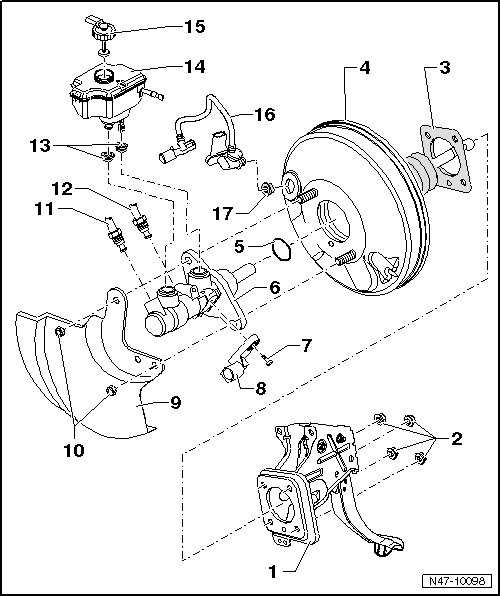
- Pedal Assembly
- Hex Nut, Self-Locking
- 25 Nm
- Always replace if removed
- First tighten at the lower left and then the upper right
- Seal
- For the brake booster
- Brake Booster
- On gasoline engines, vacuum is supplied from the intake manifold.
- Vehicles with a 2.0L gasoline engine are also equipped with a vacuum pump.
- Vehicles with a hydraulic brake booster are equipped with a vacuum sensor.
- Some gasoline vehicles with a DSG
transmission, that do not have a hydraulic brake booster are equipped
with an electric vacuum pump.Function Test:
- With the engine switched off, depress the brake pedal firmly several times (to reduce the vacuum in the device).
- Hold the brake pedal with average foot pressure and start the engine. If the brake booster is working properly, the brake pedal will be felt to give noticeably under foot (booster becomes effective).
- Replace completely if there are malfunctions (check the vacuum system for the brake booster first.
- Removing and installing.
- Seal
- Brake Master Cylinder
- Cannot be serviced. Replace as a complete unit if malfunctioning.
- Removing and installing.
- TORX Socket Bolt
- 8 Nm
- Brake Lamp Switch -F-
- Removing and installing.
- Heat Shield
- Refer to the Parts Catalog for the allocation.
- Hex Nut, Self-Locking
- 25 Nm
- Always replace if removed
- Brake Line
- 14 Nm
- Brake master cylinder/secondary piston circuit to hydraulic unit
- Brake Line
- 14 Nm
- Brake master cylinder/primary piston circuit to hydraulic unit
- Sealing Plugs
- Coat with brake fluid and press into brake fluid reservoir
- Brake Fluid Reservoir
- Cap
- Vacuum Hose
- With a check valve and also a Vacuum Sensor -G608- on vehicles with a hydraulic brake booster.
- Insert in the brake booster
- Vacuum Sensor -G608-, Removing and installing.
- Sealing Plugs
- Connection for vacuum hose
Brake Booster Vacuum Pump
Must not be disassembled.
Vacuum pump -1-.
Vacuum hose to brake booster -2- with check valve.
High pressure fuel pump -3-.
- Vacuum pump, removing and installing.
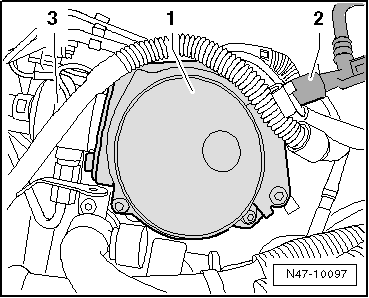
Brake Booster Vacuum System, Checking
The following checks will be helpful when performing Fault Finding if there are complaints regarding the brake booster or the so-called "hard brake pedal".
The following components are included in the check:
- Brake booster
- Seal between the brake master cylinder and the brake booster
- Check valve
- Vacuum hoses with connectors
- Vacuum pump (if equipped)
Keep the geographical surrounding in mind when evaluating the measurement results. The higher above sea level, the lower the air pressure.
Always observe all test requirements before checking the vacuum system:
- Visually inspect all of the vacuum hoses for damage (for example, tears or damage caused by animals) and secure fit
- Maintain clean working conditions when working on the vacuum system
- Clean the engine compartment before starting, if necessary
Special tools and workshop equipment required
- Brake Servo Tester -VAS6721-
Brake Servo Tester - VAS6721-, Connecting
- Remove the vacuum hose from the brake booster.
Pressing the brake pedal a few times beforehand makes it easier to remove the vacuum hose.
- Connect the Brake Servo Tester -VAS6721--see following illustrations-.
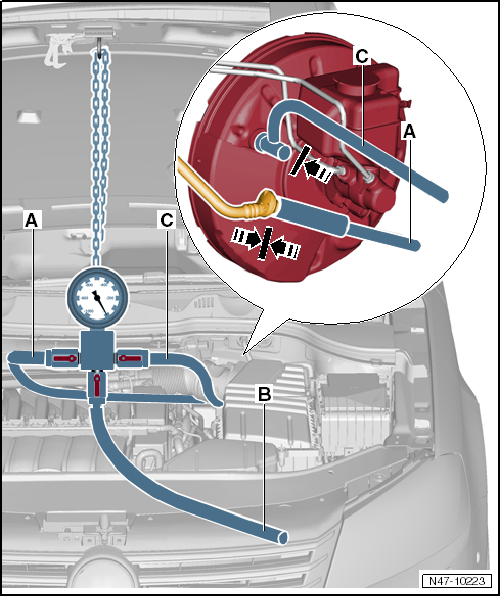
| Item number | Component | Explanation |
| A | Shut-off valve | In direction toward the vacuum hose, the check valve and vacuum pump (if equipped) |
| B | Shut-off valve |
|
| C | Shut-off valve | In the direction toward the brake booster |
- Connect the Brake Servo Tester -VAS6721- hose -A- to the vacuum hose and push the adapter -C- into the brake booster.
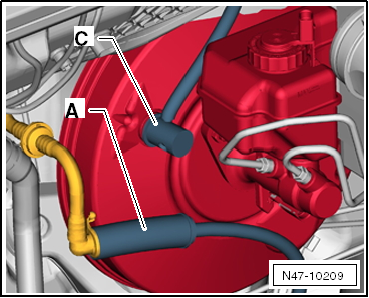
Vacuum, Checking
Note
- The average earth atmospheric air pressure at sea level (N. N.) is 1013 mbar (14.7psi) and it decreases dramatically at higher altitudes (approximately 100 mbar (1.4 psi) every 1000 meters (0.62 miles) higher). Local and time fluctuations also influence the vacuum.
- A cold engine, the A/C switched on and even only the engine idling can negatively influence the vacuum.
- Check all the vacuum hoses beforehand for damage (for example, tears or damage caused by animals) and secure fit.
- Connect the Brake Servo Tester -VAS6721-.
- Open the shut-off valve -A-.
- Close the shut-off valves -B and C-.
- Start the warm (above 60 ºC (140 ºF) engine and press the accelerator pedal one time quickly (engine RPM higher than 2,000).
- Read the displayed measured value.
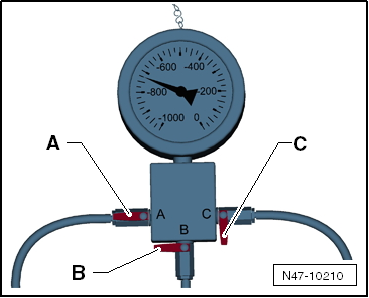
Normally (see note), the vacuum should be between 600 and 950 mbar (8.7 and 13.77 psi) (depending on the engine installed).
Check the vacuum system for leaks if the measured value is not reached, even though all requirements (see notes) are met.
- Create a vacuum using the Hand Vacuum Pump -VAS6213- for comparison purposes.
Opening the shut-off valve -B- makes it easier to remove the hose connections and the adapter.
Leak Test
Note
- The average earth atmospheric air pressure at sea level (N. N.) is 1013 mbar and it decreases dramatically at higher altitudes (approximately 100 mbar every 1000 meters (0.62 miles) higher). Local and time fluctuations also influence the vacuum.
- A cold engine, the A/C switched on and even only the engine idling can negatively influence the vacuum.
- Check all the vacuum hoses beforehand for damage (for example, tears or damage caused by animals) and secure fit.
- Connect the Brake Servo Tester -VAS6721-.
- Open the shut-off valve -A-.
- Close the shut-off valves -B and C-.
- Start the warm (above 60 ºC (140 ºF)) engine and press the accelerator pedal one time quickly (engine RPM higher than 2,000).
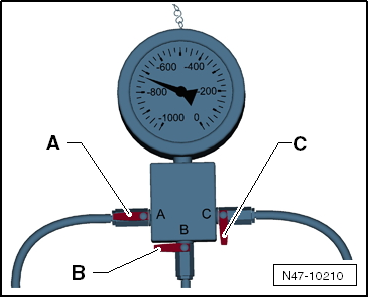
Normally (see note), the vacuum should be between 600 and 950 mbar (8.7 and 13.77 psi) (depending on the engine installed).
- Open the shut-off valve -C- to evacuate the brake booster.
- Turn off the engine.
- Read the displayed measured value and write it down.
The vacuum may drop 400 mbar (5.8 psi) within 12 hours.
If the drop in vacuum is greater, check the....
- Brake Booster
or in the - Check Valve, Vacuum Hoses with Connections and Vacuum Pump/Intake Manifold
for leaks.
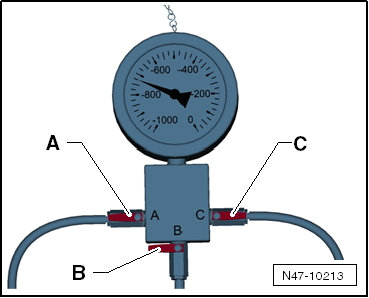
The vacuum will drop considerably within a few seconds if there are large leaks.
Vacuum, Checking near Brake Booster
- Close the shut-off valve -A- after creating the vacuum to test the brake booster vacuum.
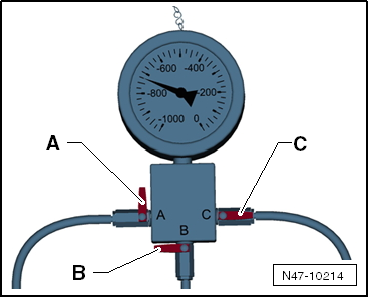
Vacuum test near the check valve, vacuum hoses and connections and vacuum pump/intake manifold
- Close the shut-off valve -C- after creating the vacuum to check the Brake Servo Tester -VAS6721- vacuum up to the intake manifold or up to the vacuum pump.
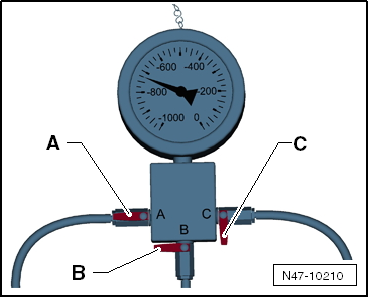
Opening the shut-off valve -B- makes it easier to remove the hose connections and the adapter.
Vacuum, Creating with Hand Vacuum Pump - VAS6213-
In certain situations, the vacuum can be created using a Hand Vacuum Pump -VAS6213- instead of using the engine or a vacuum pump.
- To do so, connect the Hand Vacuum Pump -VAS6213- to the vacuum hose of the connection -B- on the Brake Servo Tester -VAS6721-.
- Open the shut-off valve -B-.
- Create the vacuum using the Hand Vacuum Pump -VAS6213- until a vacuum between 600 and 950 mbar (8.7 and 13.77 psi) on the Brake Servo Tester -VAS6721- is displayed.
- Then perform the relevant tests.
Check Valve, Checking
- The check valve -A- must allow air to flow through in the direction of -arrow-.
- The check valve must remain closed for the opposite direction.
Observe the correct installation position!
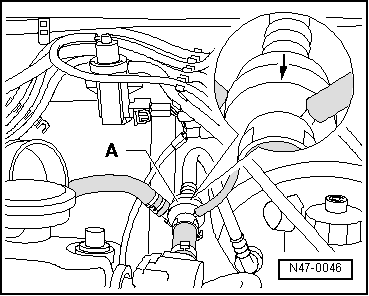
Vacuum Sensor -G608-, Removing and Installing
- Remove the engine cover.
- Remove the vacuum hose with the Vacuum Sensor -G608- from the brake booster.
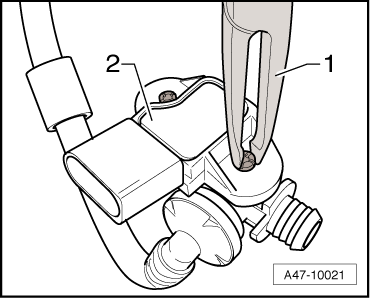
- Release the clips using pliers -1-.
- Carefully pry down the Vacuum Sensor -G608--2-.
Overview - Electric Vacuum Pump
Only on gasoline vehicles with DSG transmission without a hydraulic brake booster.
Do not disassemble the electric vacuum pump.
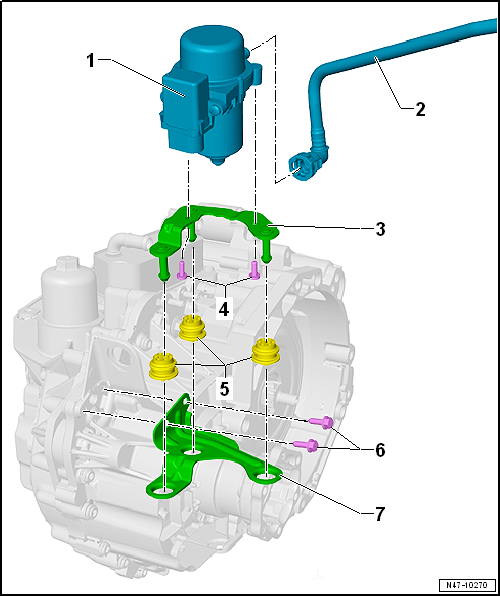
- Brake System Vacuum Pump -V192-
- Component location: in the engine compartment above the engine transmission separating point.
- Removing and installing.
- Vacuum Line
- With Brake Booster Pressure Sensor
- Refer to the Parts Catalog for the allocation.
- Bracket
- Bolted to the Brake System Vacuum Pump -V192-.
- Bolt
- 8 Nm
- Quantity: 2
- Rubber Bushing
- Refer to the Parts Catalog for the allocation.
- Quantity: 3
- Do not press the rubber bushings out of the bracket during installation
- Bolt
- 25 Nm
- Quantity: 2
- Bracket
- Secured on the transmission
Electric Vacuum Pump, Removing and Installing
Removing
- Remove noise insulation below engine/transmission.
- Remove the connector -4- from the electrical vacuum pump -1-.
- Remove the vacuum line -3- from the electric vacuum pump.
- Press the electric vacuum pump -1- out of the bracket rubber bushing -2- upward in the -direction of the arrow-.
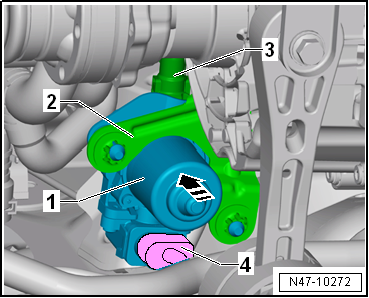
Installing
- Install in reverse order of removal.
Note
If the electric vacuum pump is replaced then the bracket → Item can be transferred.
- Install the noise insulation below the engine/transmission.
 Brake System, Bleeding
Brake System, Bleeding
The bleeding of brake system is described using the Brake Charger/Bleeder
Unit -VAS5234-.
WARNING
Only use new brake fluid conforming to VW standard (VW 501 14).
Note
Brake fluid is poisonous. Due ...
 Brake Lamp Switch -F-, Removing and Installing
Brake Lamp Switch -F-, Removing and Installing
Removing
On vehicles with a coded radio, note the code and if necessary retrieve
it.
Disconnect the battery.
Remove the intake hose, air filter housing and battery.
Remove the battery carrier. ...
See More:
Volkswagen Tiguan Owners Manual > Vehicle battery: Checking the vehicle battery electrolyte level
Fig. 166 In the engine compartment:
Remove the cover from the vehicle battery.
Fig. 167 In the engine compartment:
Open the sleeve covering of the vehicle battery.
Read and follow the introductory information and
safety information first⇒Introduction
to the subject Check the electrolyt ...
Volkswagen Tiguan Owners Manual
Volkswagen Tiguan Service and Repair Manual
- Body exterior
- Body Interior
- General Paint Information
- Paint
- Brake System
- Suspension, Wheels, Steering
- Wheel and Tire Guide
- Towing Guide
- Wheel and Tire Guide General Information
- Communication
- Electrical Equipment General Information
- Electrical Equipment from 06/2011
- Heating, Ventilation and Air Conditioning
- Refrigerant R134a Servicing
- 6-Speed Manual Transmission 02Q, OBB, and OFB
